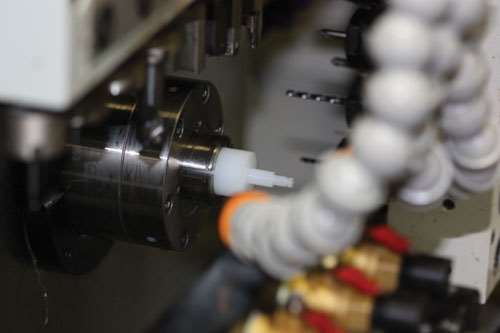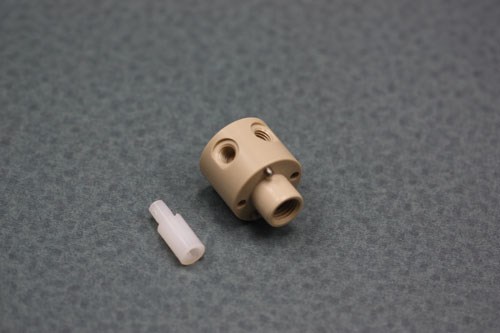Turn-Mill Machines Turn a Shop's Situation Around
It often takes seeing a machine in action to conjure up a solution to a shop’s problem. This was the case for Steve Walters, an engineer at TriContinent Scientific Inc.
It often takes seeing a machine in action to conjure up a solution to a shop’s problem. This was the case for Steve Walters, an engineer at TriContinent Scientific Inc. (Grass Valley, Calif.). When he saw the Ganesh Cyclone CNC turn-mill center from Ganesh Machinery Inc. at MD&M West (the Medical Design and Manufacturing Show) several years ago, he knew his company could use it to develop a product it was having issues with.
"I happened to walk by the Ganesh machine at the show, and I sat and watched it for about an hour," Mr. Walters says. He recalls saying to himself, "I’m going to buy one of those machines to make my valve parts."
Featured Content
TriContinent, which develops OEM liquid handling components for the life science industries, was developing a syringe pump using a valve from outside suppliers, but was not satisfied with the part’s reliability and the development cycle was too slow. That’s when Mr. Walters discovered the Cyclone.
The fact that the machine has a small footprint and a sliding headstock are the characteristics that initially drew Mr. Walters to the machine. "I went back and studied the drawings of our parts, and then I talked to Ganesh and sent them the drawings. I asked if they thought we could use this machine for our purposes, and they said yes."
The company’s first Cyclone CNC turn-mill machine was purchased in 2005 (CY-25M), and it has since bought two more Cyclones, the 32 CY (four axis) and the 32 CS (seven axis).
Mostly plastic parts are processed on the machines, and some of the coolant systems have been modified for these special parts. "Basically, we make a valve body and a valve plug that goes into the body," Mr. Walters explains. "The whole geometry, including the finish, is very critical to the reliability of the valve.
"Typically, we run the more complex valve plug on the seven-axis machine. The simpler valve body is processed on the four-axis machine, because on the valve body, all we have to do is put it in the chuck and face the other end," Mr. Walters says. "This is better than retooling the seven-axis for machining the bodies, because just to face the backside of the part on the more capable machine doesn’t really make sense. The first machine we bought is the one I use for R&D."
The Ganesh Cyclone is a sliding headstock CNC lathe without a guide bushing. Swiss machines, in general, are often misapplied by running parts that do not have the length-to-diameter ratio that requires a guide bushing. Bushless Swiss machines were developed to accommodate these kinds of workpieces.
The seven-axis Cyclone used by TriContinent uses 32-mm diameter bar, features a total of 27 tool stations, has a main spindle with a 7.5-inch X-axis stroke, a Y-axis travel of 11 inches for full off-centerline machining capability, and a Z axis with 6.5 inches of headstock movement. The machine is equipped with 5-hp (10-hp optional for main spindle) main and counter spindle motors, each with 6,000-rpm spindles.
The four-axis machine also uses 32-mm diameter bar, but features 18 tool stations. It includes a 7.5-hp spindle motor (10-hp optional) with a 6,000-rpm spindle.
Mr. Walters says he doesn’t think his company would have been able to develop the product without these machines. "Having the equipment in-house has made all the difference. I can design special tools for it, program it myself and run parts."
Moving the creation of these parts in-house not only makes the process more manageable, but also saves the company time. "We estimate that we were able to cut our development time in half with these machines," Mr. Walters says.
The machines have also proven to save the company money in more than one way. "We are able to make 50,000 standard parts that we had been buying from another machine shop, saving ourselves about $3 per part. That alone more than pays for the machine," says Mr. Walters. He also mentions that he thinks the price of the machines is a good deal compared with other machines that offer the same operations.
For Mr. Walters, what started out as a typical trade show visit turned into a momentous day after he studied the operation of the Cyclone. His visit changed the way TriContinent would manage and machine a critical part for years to come, with the benefits of efficiency, cost savings and time savings.
RELATED CONTENT
-
Custom Tooling, Workholding Help Whip Rotors Into Shape
Whipple Superchargers uses unique form tools and dead-length-collet workholding for its B-axis turn-mill enabling it to create more accurate rotors for its brand of engine power-adders.
-
Turning Machines Help Firearms Supplier Achieve Rapid Growth
Working closely with its machine tool supplier, this firearms manufacturer has quickly expanded its lineup of turning machines to deliver quality products and faster delivery.
-
Keeping Watch on Small Parts
From watch parts to exotic medical applications, this shop takes on the world of micromachining.









